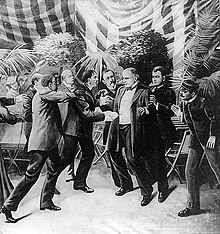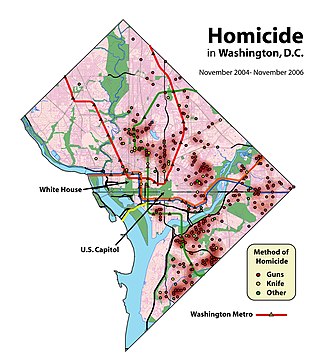美國槍械暴力問題:修订间差异
小 新條目 |
(没有差异)
|
2009年3月14日 (六) 17:47的版本
槍支暴力在美國

槍支暴力在美國與大多數兇殺案和超過一半以上的自殺案有關。[1][2]這是一個重大的公眾議題,特別是在城市地區,並與青年活動和幫派暴力息息相關。[3][4]槍支暴力自1865年林肯總統、詹姆斯‧加菲爾德總統、威廉‧麥金利和約翰‧肯尼迪暗殺案以來對美國人來說不是什麼新鮮事。而重大的槍枝暴力事件,如暗殺羅伯特‧肯尼迪、馬丁路德‧金,以及最近的哥倫拜中學大屠殺、華盛頓狙擊手攻擊事件、弗吉尼亞理工大學屠殺事件,也引發對槍枝政策的辯論。[5]
許多美國人身受非致命槍傷。根據美國疾病控制和預防中心 (Centers for Disease Control and Precention,簡稱 CDC)於2000年的估計總共52447起蓄意與23237起意外非致命槍傷。[6]在美國大多數槍有關的死亡事件是自殺,[7]2004年共有涉入槍支使用的16907起自殺事件。[1]在美國聯邦、州和地方各級的法律政策試圖通過各種方法解決槍支暴力,包括限制由青年和其他“風險”的族群購買槍支、為購買槍支設置等待時間、建立槍枝“購回”計劃、針對性執法和警務策略、違反槍支法者從重量刑、為家長和子女開設教育課程、以及社區推廣方案。研究顯示其結果好壞參半,一些政策如槍“購回”方案沒什麼用,而波士頓停火行動 (一種幫派暴力減少策略)已成為一項有效的干預策略。[8]槍枝管理政策在美國受到美國憲法第二次修訂案的強烈影響,該法案禁止侵犯“人民持有和攜帶武器的權利”。擁槍權倡導者普遍鼓勵了嚴格的捍衛第二修正案所保障的權利。
與槍枝有關的暴力犯罪
兇殺案




19世紀,正當人們正擔心暴力犯罪之時,在城市裡的兇殺案往往以暴動和其他造成社會動盪的形式進行。[12]然而,槍枝暴力有時候在這些暴動中插上一腳(見乾草市場暴亂)。在當時,許多城市(如費城)兇殺案發生率明顯低於今日。[13]
八十年代和九十年代初,城市兇殺率飆高的現象橫跨美國(見右圖)。[14]自1985年到1993年,手槍殺人案幾乎佔了所有總體增加的殺人率,而相對的涉及其他武器兇殺案發生率在這一時段走下坡。[15]在美國80年代和90年代初兇殺案發生率有上升趨勢,最明顯的是青少年、拉丁美洲裔、以及非裔美國人男性,而年紀13到17歲黑人的傷亡率是一般水平的3倍,18到24歲傷亡率則是兩倍。[11][16]遍布美國各城市吸食可卡因人數的上升一般被認為是在這段期間橫行於青少年間槍支暴力的因素之一。[17][18][19]
在美國的犯罪率類似的其他已開發國家。儘管如此,許多發展中國家有顯著較高的兇殺案發生率;而在某些國家槍械使用的兇殺案較高,這些國家包括墨西哥、巴西、泰國、瓜地馬拉、牙買加、千里達和多巴哥、哥倫比亞、愛沙尼亞、以及俄羅斯。[15][20][9]
在美國兇殺案和暴力犯罪最普遍的地點是城市地區。在大都會地區,根據2005年統計,每10萬人就有6.1件兇殺案,相形之下非大都會的州郡僅有3.5件。[21]在美國超過25萬人以上的都市平均兇殺率是每10萬人有12.1件。[22] 而與槍枝有關的兇殺案發生率在南部與西部州最多。[23]
美國各地介於18歲到24歲的兇殺案發生率從1993年來漸趨下跌,不過仍較1980年代前發生率為高。[11]根據2005年的統計,17至24歲年齡群暴力犯罪統計數據仍舊鶴立雞群於整體數據,特別是涉及槍支的凶殺案。[24] 在2005年統計數據中,17歲至19歲佔美國全人口的4.3%。[25]同一年齡群佔死於槍支兇殺案人數的11.2%。[2]該年齡群也在所有殺人犯罪佔10.6%。[26]20-24歲年齡群佔美國人口的7.1%,[25]而佔死於槍支兇殺案人數的22.5%。[2]該年齡群也佔所有兇殺犯罪活動的17.7%。[26]17歲以下在兇殺案統計資料裡表現持平。在2005年,13至16歲佔美國總人口的6%,但只佔槍枝兇殺案受害者的3.6%,[2]同時僅佔總體殺人犯罪活動的 2.7%。[26]
有案底的人亦較容易成為兇殺案的被害人。[16] 在1990年和1994年間在波士頓,佔所有兇殺案年紀低於21歲的受害人中的75%有前科記錄。[27]另一方面在費城,那些在涉及槍隻兇殺案中有案底的受害人百分比從1985年的73%增加到1996年的93%。[16]引用错误:没有找到与<ref>对应的</ref>标签
2005年該年在美國10,100件確認槍隻使用的凶殺案中,75%確認使用手槍,相形之下4%使用步槍、5%使用散彈槍,剩下的並未指名槍枝類型。[28]由於槍枝本身對事態有著潛在致命的能力,故不管受害者或施害者攜槍,其結果很可能傷亡的機率大為增加。[29]心臟遭受槍傷的死亡率為84% ,而心臟遭凶器刺傷後存活率為30%,[30]也就是70%的死亡率。
對美國總統的暗殺與嚐試
在早期美國歷史上最著名的暗殺事件受害人是1865年的亞伯拉罕·林肯總統。林肯總統在被槍手约翰·威尔克斯·布斯用一挺0.44口徑手槍發射的一顆子彈擊中頭部後僅活了幾小時。[31]兩任總統詹姆斯·加菲尔德和威廉·麦金莱均死於手槍暗殺;加菲尔德總統被兇手使用0.44口徑手槍打死;麥金利總統被從0.32口徑左輪手槍射出的兩顆子彈打死。[31]约翰·肯尼迪總統被李·哈維·奧斯瓦爾德用手動上膛的卡爾卡諾M1891/38步槍(6.5×52毫米)暗殺。安德鲁·杰克逊總統和哈利·S·杜鲁门總統皆遭暗殺但全身而退,而杰拉尔德·福特總統則在隔沒幾週先後遭到兩次獨立的企圖暗殺。 [32][33][34]美國總統罗纳德·里根在遭約翰·欣克利以一挺罗姆RG-14 .22口徑左輪手槍擊中後生存下來,並且是唯一在任美國總統在身受槍傷後存活的。[35]美國前總統西奥多·罗斯福在1912年總統競選時也碰到槍傷。[36]
其他暴力犯罪
在美國,有四分之一的商業搶劫案與槍有關。[37]相比之下,涉及槍支的搶劫可能導致死亡人數是使用他種武器搶劫的3倍,[37][38][39]家庭暴力案件也有類似的模式。[40]犯罪學家菲利普·庫克(Philip J. Cook)推測,如果槍隻較不氾濫,罪犯不管如何還是很可能會犯下罪行,但會使用較不致命的武器。[41]他發現,在50個美國最大城市裡擁槍水平與持槍搶劫率相關,而並非與整體搶劫率相關。[42][43]有相當多兇殺案是另一宗暴力犯罪的副產品,而這種情況下的罪犯進行犯罪時並沒有明確或者持續的意圖要殺人或者被殺。這種案例日漸增多。[39][44]在美國,總體搶劫與施暴率也比較其他已開發國家如澳大利亞、芬蘭等為高,儘管在這些國家擁槍率遠較美國為低。[41][44]
- ^ 1.0 1.1 Self-inflicted Injury/Suicide. National Center for Health Statistics. [2006-11-06].
- ^ 2.0 2.1 2.2 2.3 Expanded Homicide Data Table 3, Murder Victims by Age by Weapon, 2005.
- ^ Bjerregaard, Beth, Alan J. Lizotte. Gun Ownership and Gang Membership. Journal of Criminal Law and Criminology. 1995, 86(1): pp. 37–58. 美國犯罪司法參考服務資料庫 162688.
- ^ Wright, James D., Joseph F. Sheley, and M. Dwayne Smith. Kids, Guns, and Killing Fields. Society. 1992, 30(1). 美國犯罪司法參考服務資料庫 140211.
- ^ Rushefsky, Mark E. Criminal Justice: To Ensure Domestic Tranquility (Chapter 7). Public Policy in the United States: At the Dawn of the Twenty-First Century. M.E. Sharpe, Inc. 2002.
- ^ WISQARS Nonfatal Injury Reports. National Center for Injury Prevention and Control. [2006-11-10].
- ^ 10 Leading Causes of Injury Death by Age Group Highlighting Violence-Related Injury Deaths, United States, National Vital Statistics System, National Center for Health Statistics, CDC, 2003
- ^ Committee on Law and Justice. Executive Summary. Firearms and Violence: A Critical Review. National Academy of Science. 2004.
- ^ 9.0 9.1 The Seventh United Nations Survey on Crime Trends and the Operations of Criminal Justice Systems (1998 - 2000). United Nations Office on Drugs and Crime (UNODC). [2006-11-08].
- ^ Homicide trends in the U.S. - Weapons used. Bureau of Justice Statistics.
- ^ 11.0 11.1 11.2 Homicide trends in the U.S. - Age trends. Bureau of Justice Statistics.
- ^ Friedman, Lawrence M. Chapter 8: Lawful Law and Lawless Law: Forms of American Violence. Crime and Punishment in American History. Basic Books. 1993. ISBN 0-465-01461-5.
- ^ Lane, Roger. Violent Death in the City: Suicide, Accident, and Murder in Nineteenth-Century Philadelphia. Ohio State University Press. 1999. ISBN 0-8142-5021-1.
- ^ Fox, James Alan, Marianne W. Zawitz. Homicide trends in the United States. Bureau of Justice Statistics.
- ^ 15.0 15.1 Committee on Law and Justice. Chapter 3. Firearms and Violence: A Critical Review. National Academy of Science. 2004.
- ^ 16.0 16.1 16.2 Cook, Philip J., Jens Ludwig. Chapter 2. Gun Violence: The Real Costs. Oxford University Press. 2000. ISBN 0-19-513793-0.
- ^ Cork, Daniel. Examining Time-Space Interaction in City-Level Homicide Data: Crack Markets and the Diffusion of Guns Among Youth. Journal of Quantitative Criminology. 1999, 15: pp. 379–406. doi:10.1023/A:1007540007803. 美國犯罪司法參考服務資料庫 180974.
- ^ Grogger, Jeff, Mike Willis. The Introduction of Crack Cocaine and the Rise of Urban Crime Rates. National Bureau of Economic Research Working Paper No. 6352. National Bureau of Economic Research. 1998.
- ^ Blumstein, Alfred. Youth Violence, Guns and the Illicit-Drug Industry. Journal of Criminal Law and Criminology. 1995, 86(1): pp. 10–36. doi:10.2307/1143998. 美國犯罪司法參考服務資料庫 162687.
- ^ Krug, E.G, K.E. Powell, L.L. Dahlberg. Firearm-related deaths in the United States and 35 other high- and upper-middle income countries. International Journal of Epidemiology. 1998, 7: pp. 214–221. doi:10.1093/ije/27.2.214.
- ^ Crime in the United States by Community Type, 2005. Federal Bureau of Investigation.
- ^ Rate: Number of Crimes per 100,000 Inhabitants by Population Group, 2005. Federal Bureau of Investigation.
- ^ Murder, Types of Weapons Used Percent Distribution within Region, 2005. Federal Bureau of Investigation.
- ^ Butts, Jeffrey A., Howard N. Snyder. Too Soon to Tell: Deciphering Recent Trends in Youth Violence. Issue Brief. Chapin Hall Center for Children, University of Chicago. November 2006.
- ^ 25.0 25.1 American Fact Finder. United States Census Bureau.
- ^ 26.0 26.1 26.2 Expanded Homicide Data Table 3, Murder Offenders by Age, Sex, and Race, 2005.
- ^ Kennedy, David M., Anne M. Piehl, Anthony A. Braga. Youth Violence in Boston: Gun Markets, Serious Youth Offenders, and a Use-Reduction Strategy. Law and Contemporary Problems. 1996, 59(1): pp. 147–183. doi:10.2307/1192213. 美國犯罪司法參考服務資料庫 162687.
- ^ Expanded Homicide Data Table 7 - Murder Victims by Weapon, 2001-2005. Federal Bureau of Investigation.
- ^ Cook, Philip J., Mark H. Moore. Gun Control. Wilson, James Q., Joan Petersilia (编). Crime. Institute of Contemporary Studies Press. 1995.
- ^ Asensio J.A., J. Murray, D. Demetriades; et al. Penetrating cardiac injuries: A prospective study of variables predicting outcome. J Am Coll Surg. 1998, 186: pp. 24–34. PMID 9449597. doi:10.1016/S1072-7515(97)00144-0.
- ^ 31.0 31.1 Koller, Larry. Handguns. Random House. 1957: 4.
- ^ Ward, John William. Andrew Jackson. Oxford University Press. 1962: 114.
- ^ Donovan, Robert J. Tumultuous Years. University of Missouri Press. 1996: 291.
- ^ Winget, Mary Mueller. Gerald R. Ford. Twenty-First Century Books. 2007: 86.
- ^ Ronald Reagan's Life, 1979-1982. PBS. [2008-01-14].
- ^ Miller, Nathan. Theodore Roosevelt. HarperCollins. 1993: 530.
- ^ 37.0 37.1 Cook, Philip J. Robbery Violence. Journal of Criminal Law and Criminology. 1987, 70(2). 美國犯罪司法參考服務資料庫 108118.
- ^ Kleck, Gary, K. McElrath. The Effects of Weaponry on Human Violence. Social Forces. 1991, 69: pp. 669–692. doi:10.2307/2579469. 美國犯罪司法參考服務資料庫 134329.
- ^ 39.0 39.1 Zimring, Franklin E. The Medium is the Message: Firearm Caliber as a Determinant of Death from Assault. Journal of Legal Studies. 1972, 1: pp. 97–123. doi:10.1086/467479. 美國犯罪司法參考服務資料庫 47874.
- ^ Saltzman, L., J.A. Mercy; et al. Weapon Involvement and Injury Outcomes in Family and Intimate Assaults. Journal of the American Medical Association. 1992, 267: pp. 3043–3047. PMID 1588718. doi:10.1001/jama.267.22.3043.
- ^ 41.0 41.1 Cook, Philip J., Jens Ludwig. Chapter 3. Gun Violence: The Real Costs. Oxford University Press. 2000. ISBN 0-19-513793-0.
- ^ Cook, Philip J. The Effect of Gun Availability on Robbery and Robbery Murder: A Cross-Section Study of Fifty Cities. Policy Studies Review Annual. 1979, 3: pp. 743–781.
- ^ Kleck, Gary. Targeting guns: Firearms and their control. Aldine de Gruyter. 1997.
- ^ 44.0 44.1 Zimring, Franklin E., Gordon Hawkins. Crime Is Not the Problem: Lethal Violence in America. Oxford University Press. 1997.
